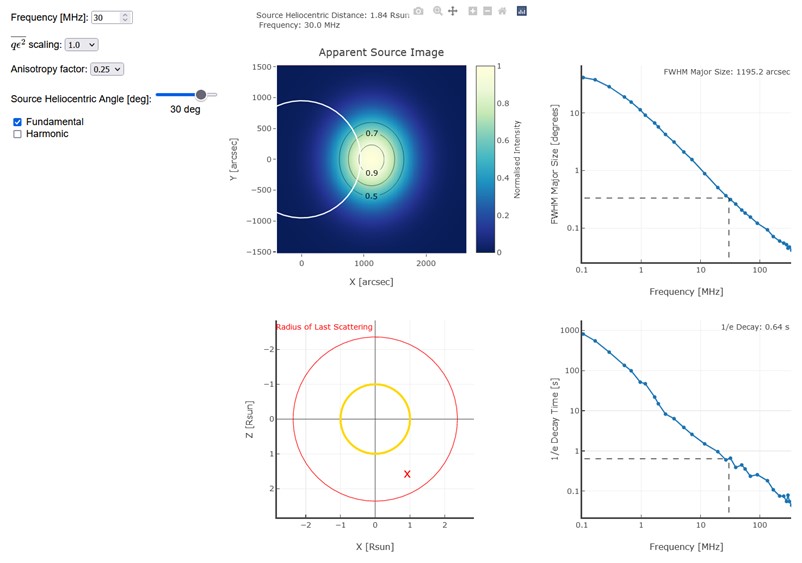The turbulent heliosphere has a significant effect on the observed characteristics of radio emission produced in, or viewed through, the solar atmosphere. In particular, radio-wave scattering on density irregularities can broaden the observed decay times and source sizes, and shift the apparent source position. Both radio burst observations and simulations have demonstrated that the turbulence is anisotropic, which can explain both the observed decay times and source sizes simultaneously. Considering that the same density turbulence modifies extra solar and solar sources, and the density fluctuations in the solar wind, a single turbulence model should be able to explain all of these observations.
The recent publication by Kontar et al. (2023) presents large-scale simulation results of injected point sources between 0.2-340 MHz subject to multiple scattering events as the emission leaves the source location. It is shown that the level of radio-wave scattering required to explain the properties of solar sources can also explain that of extrasolar sources. The model is applicable throughout the heliosphere from the Sun to 1 au and is quantified by the spectrum-weighted mean wavenumber of the density fluctuations $\overline{q\epsilon^2}$, which is proportional to the scattering rate
\[\overline{q\epsilon^2}(r)R_\odot n^2\simeq 6.5\times10^{14}\left(r/R_\odot – 1\right)^{-5.17}\]
The simulations were run across a wide parameter space with varying factors of $\overline{q\epsilon^2}$ and $\alpha$, where the latter quantifies the anisotropy of the density fluctuations ($\alpha=1$ is the isotropic case). The spread in the magnitude of $\overline{q\epsilon^2}$ between 0.5-2 and a range of $\alpha$ between 0.2-0.4 can explain the majority of observations.
Since these simulations can be extensive and take substantial time to run, we have developed a publicly available web-based tool to visualize the results of the paper (Figure 1), available at:
https://edkontar.github.io/radio_waves/
The user may enter a frequency within the bounds used in the study, along with a factor between 0.25-4 by which to scale the $\overline{q\epsilon^2}$ model, and an anisotropy factor between 0.2-0.4. The simulation results are for discrete frequencies, so we interpolate the data for any user entered frequency. By choosing the heliocentric angle of the emitter, the apparent source image will shift accordingly under the assumption that the photons propagate freely at a distance where scattering becomes negligible, forming a surface of last scattering. This radius is shown in the x-z plot (red circle), and determined from Figure 5 of Kontar et al. (2023). The tool further allows exploration of either fundamental emission or the harmonic. Finally, the apparent image may be panned by dragging across the plot, and zoomed in or out and saved (camera icon) by the controls above the plot.

Figure 1. Interactive dashboard to visualize the results of Kontar et al. (2023). The user input on the left hand side automatically updates each figure. The plots show the apparent source image (top left), the emitter location and radius of last scattering in the z-x plane (bottom left), the FWHM major size simulation results (top right), and the simulated 1/e decay time (bottom right).
We hope that the site provides a useful tool for the community to probe the effects of anisotropic scattering on solar radio sources without having to run extensive simulations.
We hope that the site provides a useful tool for the community to probe the effects of anisotropic scattering on solar radio sources without having to run extensive simulations. For those interested, we note that the simulation code is publicly available for use at the following link.
For any queries, issues, or suggestions on the website, please contact Daniel.Clarkson@glasgow.ac.uk.
Based on a recent paper: Eduard P. Kontar, A. Gordon Emslie, Daniel L. Clarkson, Xingyao Chen, Nicolina Chrysaphi, Francesco Azzollini, Natasha L. S. Jeffrey, Mykola Gordovskyy, An Anisotropic Density Turbulence Model from the Sun to 1 au Derived from Radio Observations, The Astrophysical Journal, Volume 956, Issue 2, id.112. (2023): DOI: https://doi.org/10.3847/1538-4357/acf6c1
